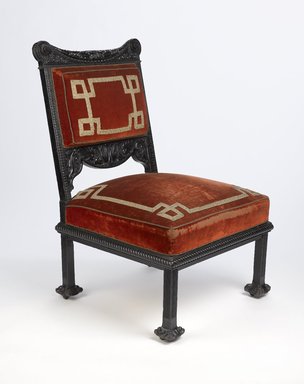
Artist:George A. Schastey
Medium: Ebonized oak, second generation upholstery, metal casters
Geograhical Locations:
Dates:ca. 1881
Dimensions: 37 1/2 x 23 x 23 1/2 in. (95.3 x 58.4 x 59.7 cm)
Collections:
Accession Number: 53.245.1
Image: 53.245.1_PS9.jpg,
Catalogue Description: TYPE: Side chairs (one of a pair) (Aesthetic Movement style) (Rockefeller residence) FRAME a. Materials: Oak b. Finish: Ebonized, appears to be original III UPHOLSTERY a. Cover: Red silk pile, replacement from 1954 b. Trim: Three types of trim: metallic cording with flange; figured galloon with metal yarns, possibly reused; outside back corded galloon, machine stitched c. STRUCTURE: Sprung seat, upholstered back (i) Webbing: Replacement; (ii) Eight springs, unavailable for inspection; (iii) Edges: Sewn to modest round; (iv) Cake: Two cakes; sewed up first cake with curled hair, additional layer that may or may not be reused from first presentation. "( Mellon Project 1997)" TEXTILE: Red-orange silk pile fabric of modern manufacture. TRIM: Three types of trim: (1) Figured galoon in pattern of conventionalized leaves has supplementary weft of gold-colored wrapped flat wire yarn, which used to be yellow and is now oxidized gray, and a silk warp. The galoon is stitched to the seat top and backrest in a simple rectangular meander pattern. (2) 1/4" diameter cord around seat edges and backrest is 3-ply plain cord, each ply consisting of metallic threads wound around yellow fiber core. Originally gold-colored, the dyes have now oxididized to gray. The cord is sewn to a 3" yellow twill tape which serves as a flange. The flange is fastened to the edge rolls with a cardboard tacking tape. (3" On the outside back, a corded gimped galoon consisting of a pale orange simple gimp (faded from red) surmounted by a 2-ply cord (pale orange, faded from untetermined original color) macine stitched in place. (Cross-referenced cord on seat perimeter of 40.604 Side Chair ( Elizabethan-Revival style). UNDERUPHOLSTRY: 8 springs. Tacking margins for cover and underupholstry (both sides) are shattered with holes, suggesting more than one refurbishment. ( see proper left rear corner of 53.245A). Viewing underupholstry from bottom, all new materials, including new cross members added to seat rails on all four sides to hold new webbing. Springs are a mix of structure and type (gray and black, some knotted) possibly some original springs remain (or they may simply represent a thrifty shop) First cake is curled hair; it may have been reused. The textile is attached in a modern way, because cording has a flange that is tacked along bottom and then the silk-pile fabric is sewn to cording. FRAME: Carved seatback, rails and fluted legs with large feet whihh are scooped out for casters. Four casters, marked " THE INDIA (RUBBER COMB) CO. NEW YORK'' on one side of the wheel. Too worn to determine if marked on the other side of the wheel. FINISH: Black paint (ebonizing) that is worn in high spots. ELEMENTS OF UPHOLSTRY THAT APPEAR TO BE ORIGNAL: Possibly some underupholstry layers.